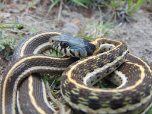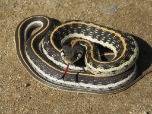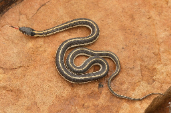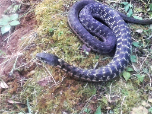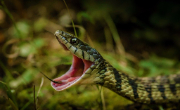 |
Black-Necked Garter Snake Range Map
|
|
|
 |
 |
 |
 |
 |
 |
 |
Black-Necked Garter Snake Video
|
|
|
 |
 |
 |
 |
 |
 |
 |
Black-Necked Garter Snake Juvenile

|
|
|
 |
 |
 |
 |
 |
 |
|
Black-Necked Garter Snake (Thamnophis cyrtopsis)
Description: Black-necked gartersnakes are striped gartersnakes, typically with a dark grey or olive-grey background color, two whitish or cream-colored side stripes on the 2nd and 3rd scale rows, and a thick, bright mid-dorsal (center of the back) stripe. The mid-dorsal stripe is strongly yellow or orange on the anterior part (closest to the head) of the body, while the side stripes are often white, resulting in a very brightly contrasting overall appearance. Black-necked gartersnakes typically have very obvious paired black neck patches on either side of the dorsal stripe at the back of the head, and the head is bluish-grey. There are obvious black stripes outlining the cream-colored or whitish labial scales on the upper and lower jaws. Adult female black-necked gartersnakes may reach 42 inches in total length.
Habitat: This snake occurs in a wide range of habitats, from desert flats, dry grasslands, and tropical lowlands to pine-oak habitats and cloud forest in mountains; in the southwestern United States it is often in the vicinity of permanent and intermittent streams, spring seepages, and irrigation canals, usually in canyons, foothills, or mountains. It inhabits rocky hillsides and limestone ledges, and wooded ravines and cedar brakes, in the Texas Hill Country. In Mexico, habitats include tropical barrancas, thorny scrub forest, tropical deciduous forest, and upper arid or mixed boreal-tropical cloud forest. This snake wanders far from water into adjacent grassland, desert, woodland, and shrubland, but mostly it is restricted to the vicinity of consistent water sources in the arid Southwest
Range: Black-necked garter snakes occur in the United States in southern Colorado, southwestern Utah, central and eastern Arizona, New Mexico (except the far eastern portion of the state), and western and central Texas. They are also widespread in Mexico and are found as far south as Guatemala.
Diet: Eats frogs, toads, tadpoles, salamanders, lizards, and crustaceans. Opportunistic forager. Forages mainly along stream banks and at pools, and at or near the water's surface
Reproduction: Black-necked garter snakes likely mate in the spring, after emerging from hibernation, as is the case for most Thamnophis species. The dominant mating system of Thamnophis species, and snakes in general, is polygynandry, but the system used by this particular species is not known. Generally, male Thamnophis tend to emerge from hibernation before females, returning to and clustering around a den in response to the release of female pheromones. Males follow the pheromone scent trail to a female in order to mate. Competition is quite high between males as females emerge from hibernation, not only due to the number of males waiting outside the den, but also to males obscuring the pheromone trails of females that they follow. In general, mating is comprised of three phases. The first is tactile chase, in which a male and female first make contact and he either lines up next to or loops over her body, using his pelvic spurs to scratch her vent. The second is tactile alignment, in which copulation attemps occur, with muscle contractions aligning the male's tail to the female's. The final stage, intromission coitus, is copulation, in which a female gapes her cloaca and allows the insertion of a male's hemipenis. Male-male combat is not uncommon, but does not typically result in injury to either party.
It is most likely that mating occurs in the spring, after hibernation, and it has been documented that most births occur from June through August. Females have been found with enlarged ovarian follicles or developing embryos between March and June, suggesting an incubation time of approximately three months. Young black-necked garter snakes are usually born near water, with each female producing 3-24 offspring at a time, with an average clutch size of eight. Males mature at about 42-47 cm in length and females mature at about 50-76 cm. Age at maturity is not definitely known for this species; however other Thamnophis species mature in their second or third year. Sperm seems to be produced by males during the late summer and autumn; it is stored by males in their vasa deferentia until mating in the spring and summer.
Status: Listed as Least Concern in view of the large and probably relatively stable extent of occurrence, area of occupancy, number of subpopulations, and population size. No major threats are known.
»» Kingdom: Animalia - Animals
»» Phylum: Chordata - Chordates
»» Subphylum: Vertebrata - Vertebrates
»» Class: Reptilia - Reptiles
»» Order: Squamata - Scaled Reptiles
»» Suborder: Serpentes
»» Superfamily: Colubroidea
»» Family: Colubridae - Colubrids
»» Genus: Thamnophis
»» Species: Thamnophis cyrtopsis - Black-Necked Garter Snake
»» Subspecies:
»» Thamnophis cyrtopsis cyrtopsi - Western Black-necked Garter Snake
»» Thamnophis cyrtopsis ocellatus - Eastern Black-necked Garter Snake
This article uses material from the Wikipedia article "Blackneck garter snake", which is released under the Creative Commons Attribution-Share-Alike License 3.0. Content may have been omitted from the original, but no content has been changed or extended.
|
|




